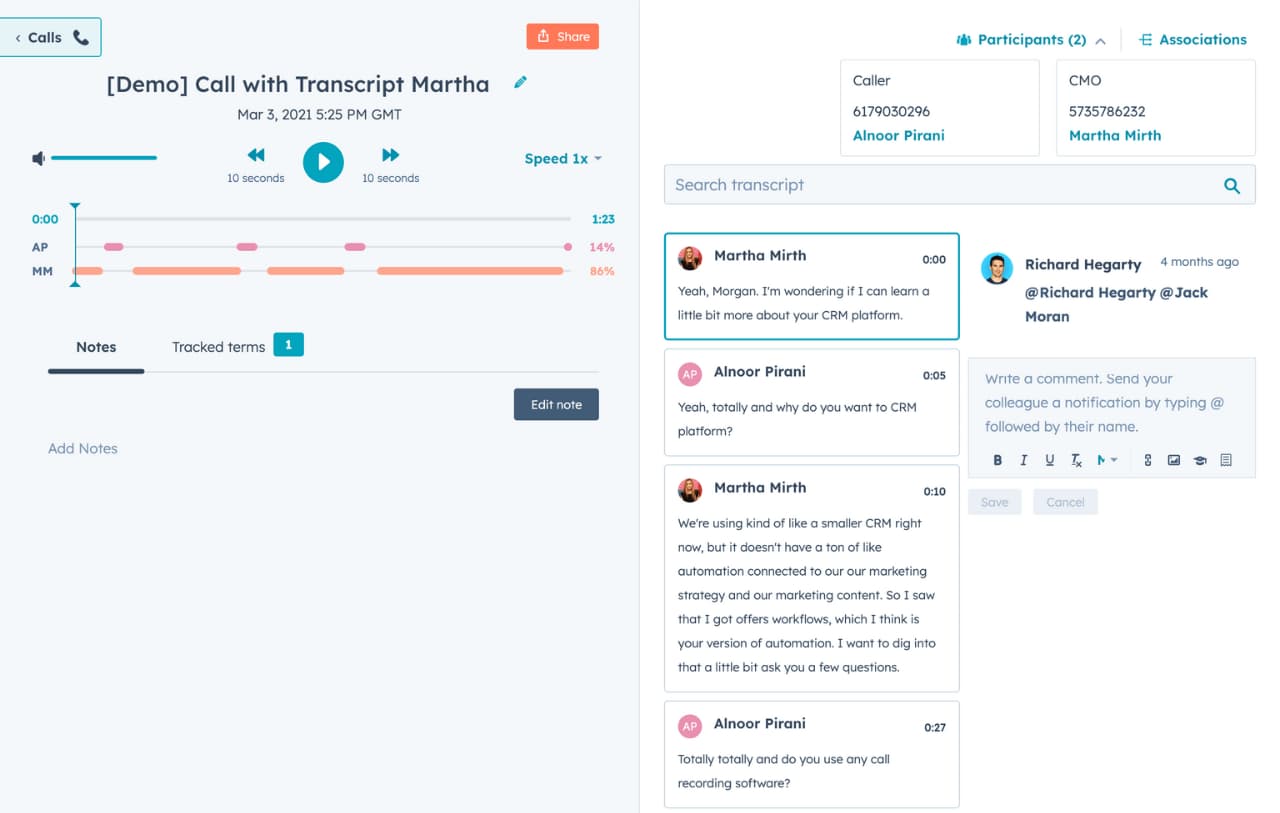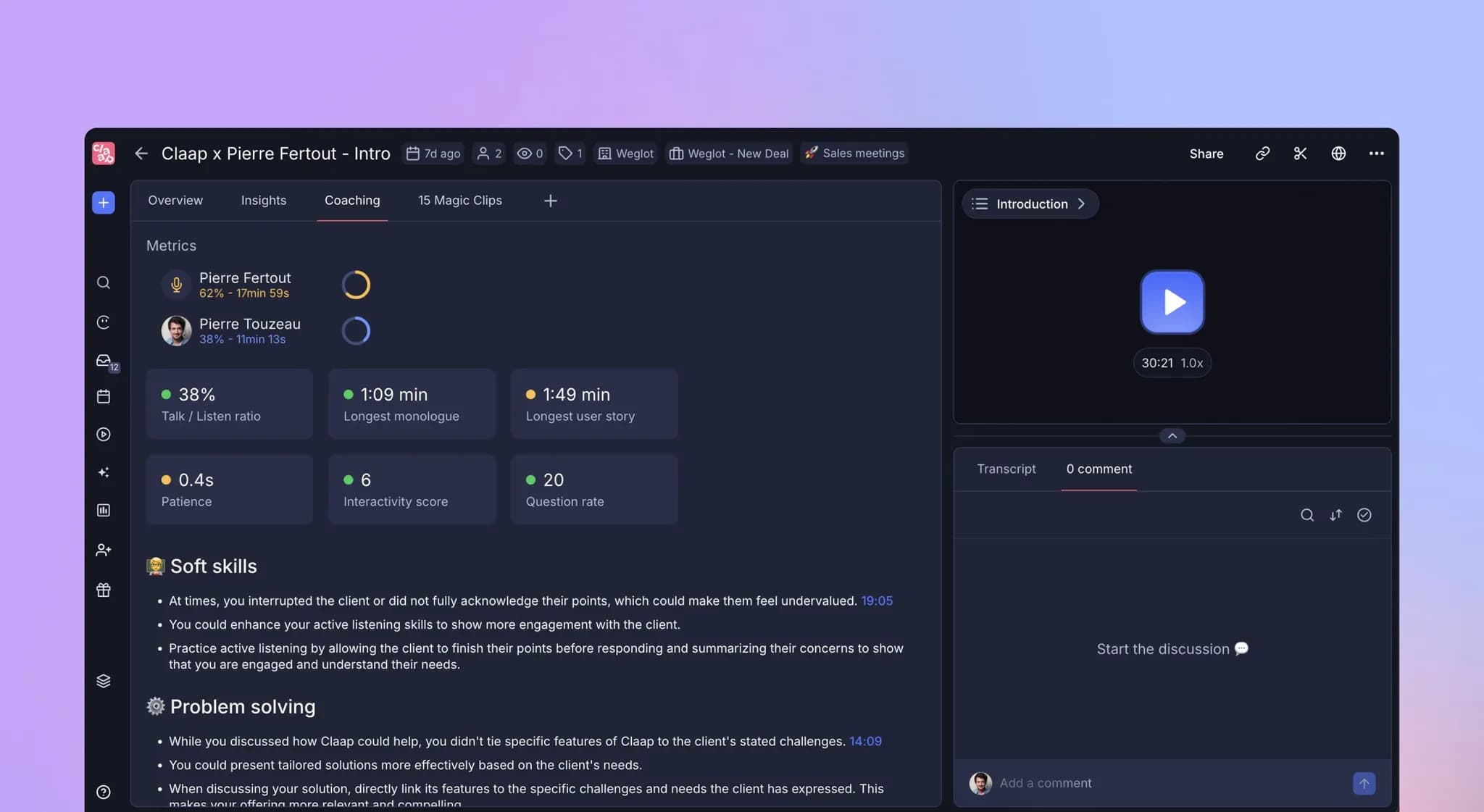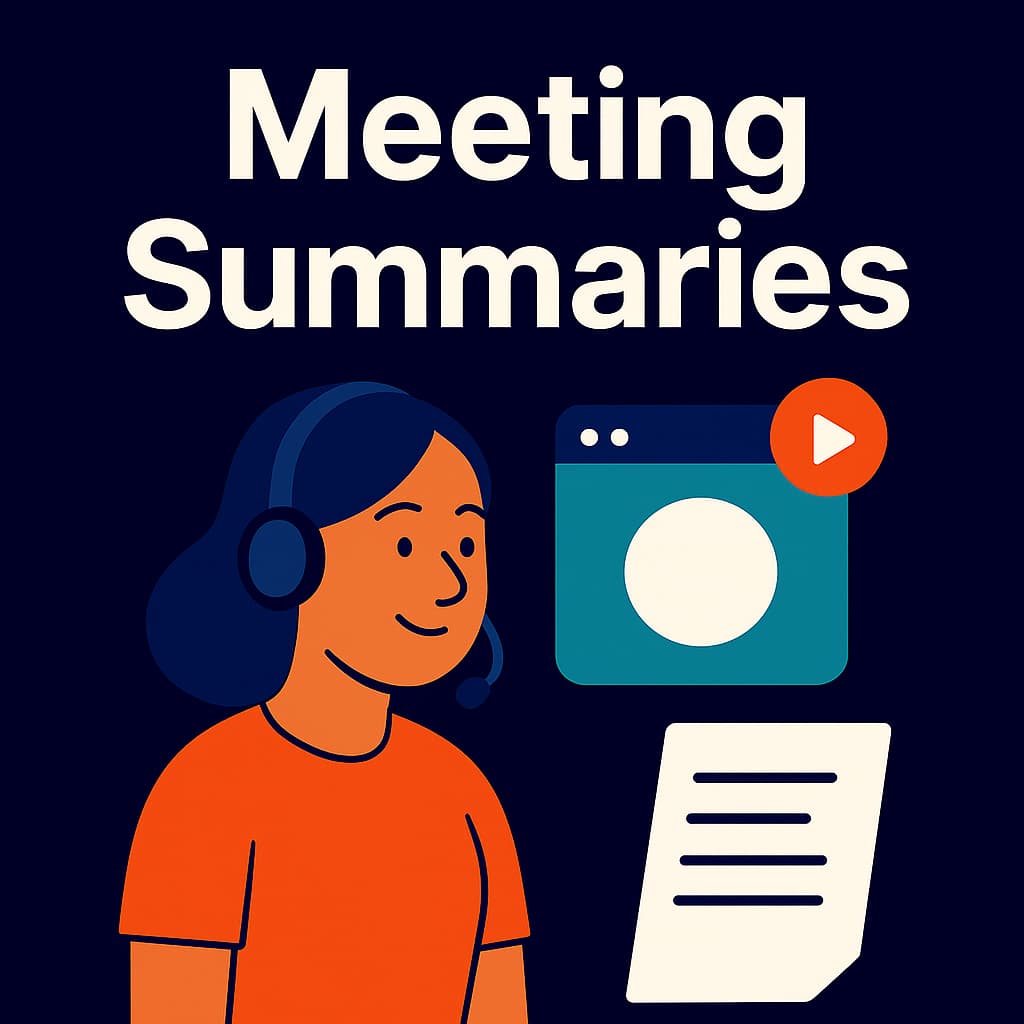
HubSpot Notetaker vs Alternatives: What’s Best for Sales Teams in 2025?
The meeting notetaker landscape is rapidly evolving, with CRM platforms like HubSpot now offering built-in AI notetaking capabilities that directly compete with standalone tools like Fathom, Grain, Otter, Gong, Fireflies, and Claap. This shift has sparked an important debate among sales professionals: Are external meeting notetakers still worth the investment when your CRM already includes notetaking features?
The Rise of Native CRM Notetakers
HubSpot’s native notetaker — a first mover among CRM tools
HubSpot's integrated meeting notetaker represents a significant shift in how sales teams approach call documentation. Unlike external tools that require additional tabs, logins, and integrations, HubSpot's native solution promises seamless workflow integration that eliminates friction during sales calls.
Important limitation: If you use Google Meet, HubSpot's notetaker only supports English transcripts — a critical drawback for international sales teams or multilingual organizations.
Key advantages of HubSpot's built-in notetaker:
- Direct integration with your existing CRM data
- No additional software costs for basic functionality
- Simplified user experience with fewer tools to manage
- Automatic sync with contact records and deal stages
However, industry experts are questioning whether this convenience comes at the cost of functionality and effectiveness.

The Case for External Meeting Notetakers
Despite the appeal of native solutions, many sales professionals continue to rely on specialized note-taking tools. Here's why:
1. Superior AI Quality and Customization
According to Daniel Zarick, CEO at Arrows,
In AI, the gap between the best-in-class tool and the 3rd best tool is massive.
This quality difference becomes critical when building entire sales workflows around meeting insights. External tools often provide:
- Customizable note summaries based on call type and industry
- Advanced AI models trained specifically for sales conversations
- Automated property updates in your CRM based on call content
- Industry-specific templates for different types of sales meetings
2. Cross-Platform and Multi-Language Support
Robert Vossen, CEO of Signalist, highlights a crucial limitation:
No notetaker works in all environments.
Sales teams often need tools that work across:
- Multiple video conferencing platforms (Zoom, Teams, Google Meet)
- Different CRM systems beyond HubSpot
- Various internal communication tools
- External client meeting environments
This becomes especially critical when considering HubSpot's severe language restrictions. If your organization uses Google Meet and conducts any sales calls in languages other than English, HubSpot's native notetaker is not a viable option. External tools typically support dozens of languages across all major video conferencing platforms, making them essential for:
- International sales teams
- Companies serving non-English speaking markets
- Multilingual organizations with diverse customer bases
- Global enterprises with regional sales offices
3. Advanced Integration Capabilities
John McArdle from Sequoia Solutions emphasizes that external tools excel at
The ability to customize summaries based on the type of call and auto-update properties."
This includes:
- Sophisticated API integrations with multiple business tools
- Custom workflow automations based on call content
- Advanced reporting and analytics across all customer interactions
- Data export capabilities for business intelligence platforms
4. Comprehensive Meeting Intelligence and CRM Integration
Tools like Claap take meeting documentation beyond simple transcription by offering deep integration with sales processes:
- Semantic search capabilities across all meeting transcripts to find specific topics, pain points, or competitor mentions
- Deal and contact database integration that connects recordings to your sales pipeline
- Advanced filtering and tagging for topics like objections, competitor mentions, and pain points
- Team collaboration features that allow sales managers to review and coach based on actual conversation content
- Meeting analytics that help identify patterns across successful and unsuccessful sales calls
These specialized platforms often provide sales teams with business intelligence capabilities that go far beyond what general-purpose CRM notetakers can offer.
Current Limitations of HubSpot's Meeting Notetaker
Based on extensive user feedback and official documentation, several key limitations emerge with HubSpot's native solution:
Technical Constraints
- Recurring meeting issues: The notetaker may not reliably join recurring meetings
- Beta reliability problems: Users report inconsistent performance during the beta phase
- Booking limitations: Doesn't work when meetings are booked by colleagues rather than the account owner
- Sharing restrictions: Cannot share recordings/transcripts with contact-only users

Platform-Specific Limitations
CRITICAL: Google Meet Language Restriction
HubSpot's meeting notetaker has a severe limitation when used with Google Meet: it only supports transcripts in English. This means:
- International sales teams conducting calls in Spanish, French, German, Mandarin, or any other language cannot use HubSpot's notetaker with Google Meet
- Multilingual organizations must either switch to Microsoft Teams or Zoom, or use external notetaker tools
- Sales teams serving global markets are effectively excluded from using this feature if they primarily use Google Meet
Other Platform Considerations:
- Caption dependency: Meeting transcripts rely on your meeting software provider's caption settings, requiring you to enable captions/live captions in your meeting software
- Caption language matching: The caption language must match the language used in the meeting for accurate transcription
- Platform integration variance: While HubSpot's Microsoft Teams and Zoom integrations provide more stable transcript capture, there are provider-specific considerations and limitations for each platform
- Setup complexity: Each video conferencing platform requires specific configuration to ensure captions are properly enabled and configured
Business Process Limitations
- Limited customization: Cannot tailor notes for specific business needs or industries
- No external data integration: Cannot pass transcripts to external data infrastructure
- Universal access requirements: Non-HubSpot users need separate recording solutions
- Compliance concerns: Some organizations prefer not storing all meeting data in their CRM (legal, HR considerations)
Why Language Support Matters for Global Sales Teams
The English-only limitation for Google Meet users is not just a minor inconvenience—it's a complete barrier to adoption for many organizations. Consider these scenarios:
- European sales teams conducting calls in German, French, Spanish, or Italian cannot use HubSpot's notetaker with Google Meet
- Asian markets where sales conversations happen in Mandarin, Japanese, Korean, or Hindi are entirely excluded
- Latin American sales operations conducting business in Spanish or Portuguese must find alternative solutions
- Canadian businesses serving both English and French-speaking customers face significant operational challenges
- Multinational corporations with regional sales teams speaking different languages cannot standardize on HubSpot's tool if they use Google Meet
For these organizations, external notetaker tools that support 50+ languages across all video platforms become not just preferable, but essential for maintaining effective sales operations. This single limitation may force companies to either change their entire video conferencing platform or invest in external notetaking solutions regardless of HubSpot's native offering.
Cost Analysis: Built-in vs External Solutions
The financial equation isn't as straightforward as it initially appears:
HubSpot's pricing reality:
- Free with Sales Hub Professional ($100/seat/month)
- Not available on lower-tier plans
- Requires HubSpot licenses for all meeting participants
External tool considerations:
- Standalone pricing often ranges $20-$60/seat/month
- Can serve users across multiple CRM platforms
- May offer better ROI for companies with complex sales processes
Mitch Horvers, CCO at a business growth consultancy, notes:
I am not paying 200/300 bucks a month extra just so me and two other reps can get a few features I can scrape off the Web for cheaper cost.
Industry Expert Perspectives
The Specialization Advantage
Kim Hacker, COO at Arrows, provides crucial insight:
Purpose-built tools will always have an advantage because they're focused on meeting notes 100% of the time whereas it's such a small part of HubSpot's focus.
This specialization translates to:
- More frequent feature updates and improvements
- Deeper AI training on sales conversation data
- Better customer support for notetaking-specific issues
- Innovative features that may never appear in general CRM platforms
The Context Integration Opportunity
Tori Cook from WorkStep offers a balanced perspective:
Context is important, and if you have the entire context of your CRM partnered with every transcript, that's powerful too.
This highlights the ongoing evolution in the space, where the ideal solution might combine:
- Deep CRM integration for context
- Specialized AI for meeting insights
- Flexible workflow automation
- Cross-platform compatibility
Making the Right Choice for Your Sales Team
Choose HubSpot's Native Notetaker If:
- You conduct ALL sales calls in English (mandatory for Google Meet users)
- Your team exclusively uses HubSpot for CRM
- You primarily conduct meetings on supported platforms (Microsoft Teams or Zoom for best results)
- You can ensure captions are properly enabled in your meeting software
- Simplicity and cost-effectiveness are top priorities
- Your sales process doesn't require highly customized meeting insights
- All team members have appropriate HubSpot licenses
Disqualifying factor: If you use Google Meet and conduct any sales calls in languages other than English, HubSpot's notetaker will not work for you.
Consider External Tools If:
- You conduct sales calls in ANY language other than English while using Google Meet (this alone makes external tools mandatory)
- You conduct sales calls in multiple languages or serve international markets
- Your team uses multiple video conferencing platforms regularly
- You need consistent transcript quality regardless of platform caption settings
- You need advanced customization for different call types
- Your team uses multiple CRM platforms or business tools
- Meeting quality and AI accuracy are critical for your sales process
- You require sophisticated automation and integration capabilities
- You have complex compliance or data management requirements
- You need comprehensive meeting intelligence with semantic search capabilities (sales tools like Claap excel here)
- You want to analyze conversation patterns across your entire sales organization
- Your sales process requires detailed tracking of competitor mentions, objections, and pain points
- You're planning international expansion and need a solution that scales across languages
Which tools? Check out our article on the 8 best sales call analytics tools. We compare Claap, Gong, Fireflies, tl;dv, Modjo, Salesloft, and Clari in detail — and benchmark them against HubSpot’s Conversation Intelligence module.

The Future of Meeting Notetakers
The meeting notetaker market is experiencing rapid consolidation and innovation. The focus should be on the deeper use cases that move the needle for your customers rather than a transcript or an AI summary.
Emerging trends to watch:
- AI Agents powered by context from your conversations
- Advanced AI search across all company meetings to surface insights about competitors, objections, and successful sales strategies
- AI-powered deal coaching based on conversation analysis
- Predictive insights about deal likelihood and next steps
- Automated follow-up generation with personalized messaging
- Cross-platform conversation intelligence that works everywhere
- Meeting analytics and pattern recognition to identify what messaging resonates best with different customer segments
Recommendations for Sales Teams
- Assess your language requirements FIRST: If you use Google Meet and conduct any sales calls in non-English languages, skip HubSpot's native notetaker entirely and evaluate external tools that support multiple languages
- Audit your current workflow: Identify where meeting insights create the most value in your sales process
- Test native solutions first (English-only operations): If you're already using HubSpot and all calls are in English, evaluate their notetaker for basic needs
- Evaluate specialized platforms: Consider tools like Claap for advanced meeting intelligence, especially if you need semantic search across conversations or detailed analytics on sales patterns
- Consider hybrid approaches: Use native tools for simple calls and external solutions for high-stakes meetings
- Factor in total cost of ownership: Include training time, integration costs, and productivity impacts
- Plan for scalability: Choose solutions that can grow with your team and integrate with future tools—including international expansion plans
The choice between HubSpot's built-in notetaker and external tools ultimately depends on your specific sales process, technical requirements, and growth objectives. While native solutions offer compelling simplicity and cost benefits, specialized tools continue to provide advanced capabilities that many sales teams consider essential for competitive advantage.
Critical factors to consider include:
- Language requirements: If you use Google Meet and need any language other than English, external tools are your only option
- The reliability of caption settings across your video conferencing platforms
- The level of customization and AI sophistication your team needs
- Your budget and the total cost of ownership including training and integration
- Your plans for international expansion or serving multilingual customer bases
For international sales teams or organizations serving global markets, the language limitation alone may make HubSpot's native notetaker a non-starter, particularly for Google Meet users. In these cases, the decision isn't between native and external tools—it's which external tool best meets your needs.
As this market continues to evolve, the most successful sales organizations will be those that thoughtfully evaluate their unique needs and choose tools that amplify their team's effectiveness rather than simply following the latest trends.


